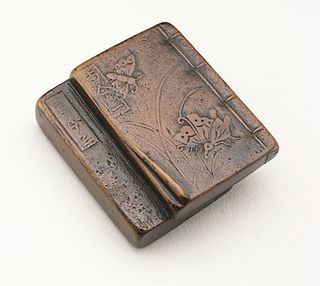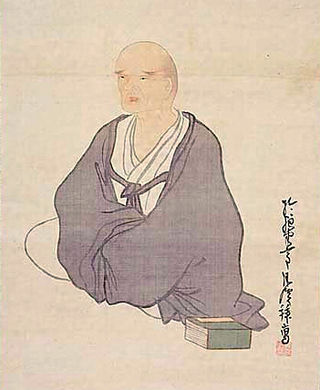
Haiku is a type of short form poetry that originated in Japan. Traditional Japanese haiku consist of three phrases composed of 17 phonetic units in a 5, 7, 5 pattern; that include a kireji, or "cutting word"; and a kigo, or seasonal reference. Similar poems that do not adhere to these rules are generally classified as senryū.
George Swede, is a Latvian Canadian psychologist, poet and children's writer who lives in Toronto, Ontario. He is a major figure in English-language haiku, known for his wry, poignant observations

Japanese poetry is poetry typical of Japan, or written, spoken, or chanted in the Japanese language, which includes Old Japanese, Early Middle Japanese, Late Middle Japanese, and Modern Japanese, as well as poetry in Japan which was written in the Chinese language or ryūka from the Okinawa Islands: it is possible to make a more accurate distinction between Japanese poetry written in Japan or by Japanese people in other languages versus that written in the Japanese language by speaking of Japanese-language poetry. Much of the literary record of Japanese poetry begins when Japanese poets encountered Chinese poetry during the Tang dynasty. Under the influence of the Chinese poets of this era Japanese began to compose poetry in Chinese kanshi); and, as part of this tradition, poetry in Japan tended to be intimately associated with pictorial painting, partly because of the influence of Chinese arts, and the tradition of the use of ink and brush for both writing and drawing. It took several hundred years to digest the foreign impact and make it an integral part of Japanese culture and to merge this kanshi poetry into a Japanese language literary tradition, and then later to develop the diversity of unique poetic forms of native poetry, such as waka, haikai, and other more Japanese poetic specialties. For example, in the Tale of Genji both kanshi and waka are frequently mentioned. The history of Japanese poetry goes from an early semi-historical/mythological phase, through the early Old Japanese literature inclusions, just before the Nara period, the Nara period itself, the Heian period, the Kamakura period, and so on, up through the poetically important Edo period and modern times; however, the history of poetry often is different from socio-political history.
Haibun is a prosimetric literary form originating in Japan, combining prose and haiku. The range of haibun is broad and frequently includes autobiography, diary, essay, prose poem, short story and travel journal.

Kobayashi Issa was a Japanese poet and lay Buddhist priest of the Jōdo Shinshū. He is known for his haiku poems and journals. He is better known as simply Issa (一茶), a pen name meaning Cup-of-tea. He is regarded as one of the four haiku masters in Japan, along with Bashō, Buson and Shiki — "the Great Four."

Yosa Buson or Yosa no Buson was a Japanese poet and painter of the Edo period. He lived from 1716 – January 17, 1784. Along with Matsuo Bashō and Kobayashi Issa, Buson is considered among the greatest poets of the Edo Period. He is also known for completing haiga as a style of art, working with haibun prose, and experimenting with a mixed Chinese-Japanese style of poetry.
SciFaiku is a form of science fiction poetry first announced by Tom Brinck with his treatise on the subject, The SciFaiku Manifesto. Brinck has been referred to as the "Father of SciFaiku." SciFaiku is inspired by Japanese haiku, but explores science, science fiction (SF), and other speculative fiction themes, such as fantasy and horror. They are based on the principles and form of haiku but can deviate from its structure.
Bruce Ross is a Canadian American poet, author, philosopher, humanities educator and past president of the Haiku Society of America. He was born in Hamilton, Ontario.

Gabriel Rosenstock is an Irish writer who works chiefly in the Irish language. A member of Aosdána, he is poet, playwright, haikuist, tankaist, essayist, and author/translator of over 180 books, mostly in Irish. Born in Kilfinane, County Limerick, he currently resides in Dublin.
The Haiku Society of America is a non-profit organization composed of haiku poets, editors, critics, publishers and enthusiasts that promotes the composition and appreciation of haiku in English. Founded in 1968, it is the largest society dedicated to haiku and related forms of poetry outside Japan, and holds meetings, lectures, workshops, readings, and contests, throughout the United States. The society's journal, Frogpond, first published in 1978, appears three times a year. As of 2022, the HSA has over 1,000 members.
Cor Van den Heuvel is an American haiku poet, editor and archivist.

Anatoly Kudryavitsky is a Russian-Irish novelist, poet, editor and literary translator.
A haiku in English is an English-language poem written in a form or style inspired by Japanese haiku. Like their Japanese counterpart, haiku in English are typically short poems and often reference the seasons, but the degree to which haiku in English implement specific elements of Japanese haiku, such as the arranging of 17 phonetic units in a 5–7–5 pattern, varies greatly.

James Michael Kacian is an American haiku poet, editor, translator, publisher, organizer, filmmaker, public speaker, and theorist. He has authored more than 20 volumes of English-language haiku, and edited scores more, including serving as editor in chief for Haiku in English: The First Hundred Years. In addition, he is founder and owner of Red Moon Press (1993), a co-founder of the World Haiku Association (2000), and founder and president of The Haiku Foundation (2009).
Leza Lowitz is an American expatriate writer residing in Tokyo, Japan and in the American Southwest. She has written, edited and co-translated over twenty books, many about Japan, its relationship with the US, on the changing role of Japanese women in literature, art and society, and about the lasting effect of the Second World War and the desire for reconciliation in contemporary Japanese society. She is also an internationally renown yoga and mindfulness teacher recognized for her work bridging poetry and the spiritual path through disciplines like yoga and mindfulness.
Paul Terence Conneally is a poet, artist and musician based in Loughborough, UK.
Roger Jones is an American poet.
Ram Krishna Singh is a reviewer, critic, and contemporary poet who writes in Indian English.
The British Haiku Society (BHS) was formed in 1990 and aims to promote haiku and to teach and publish Haiku in English.
Alexis K. Rotella is an American poet and artist. She has written poems in several of the traditional styles of Japanese poetry, including haiku, senryū, renga, and haibun.








